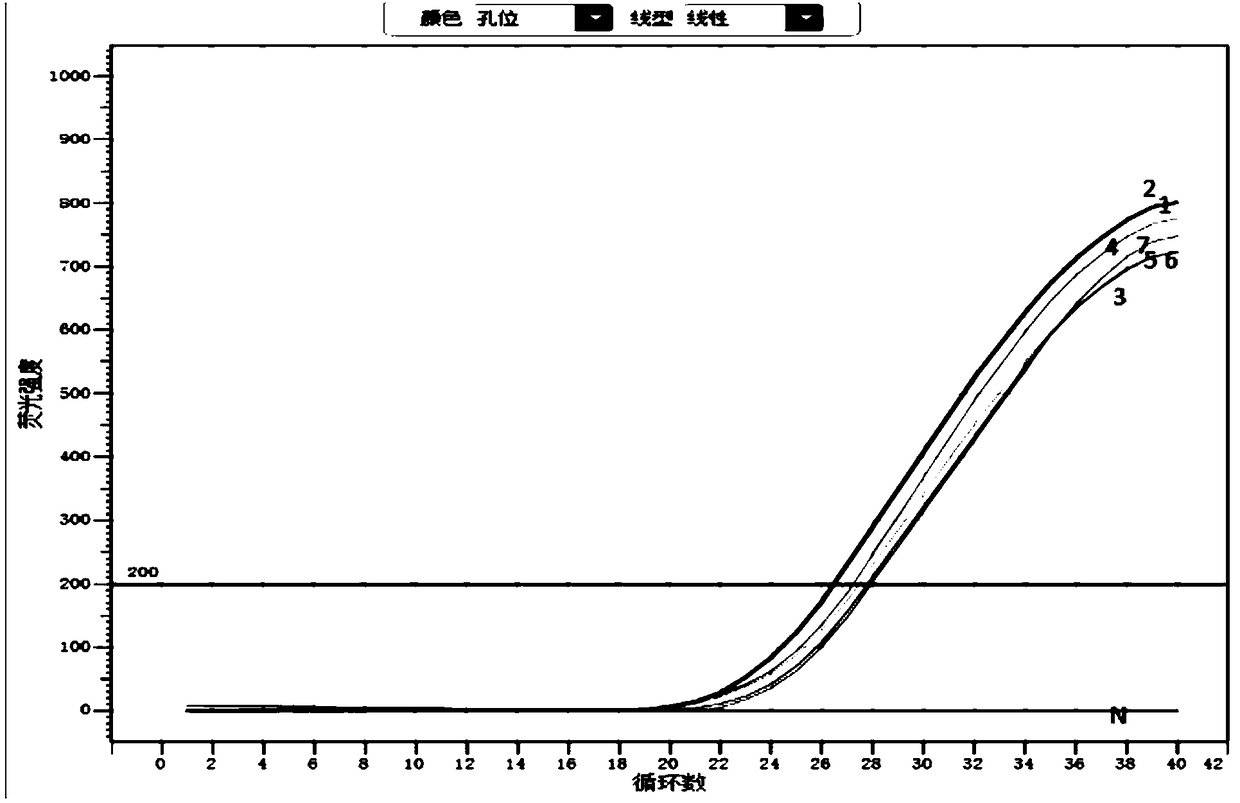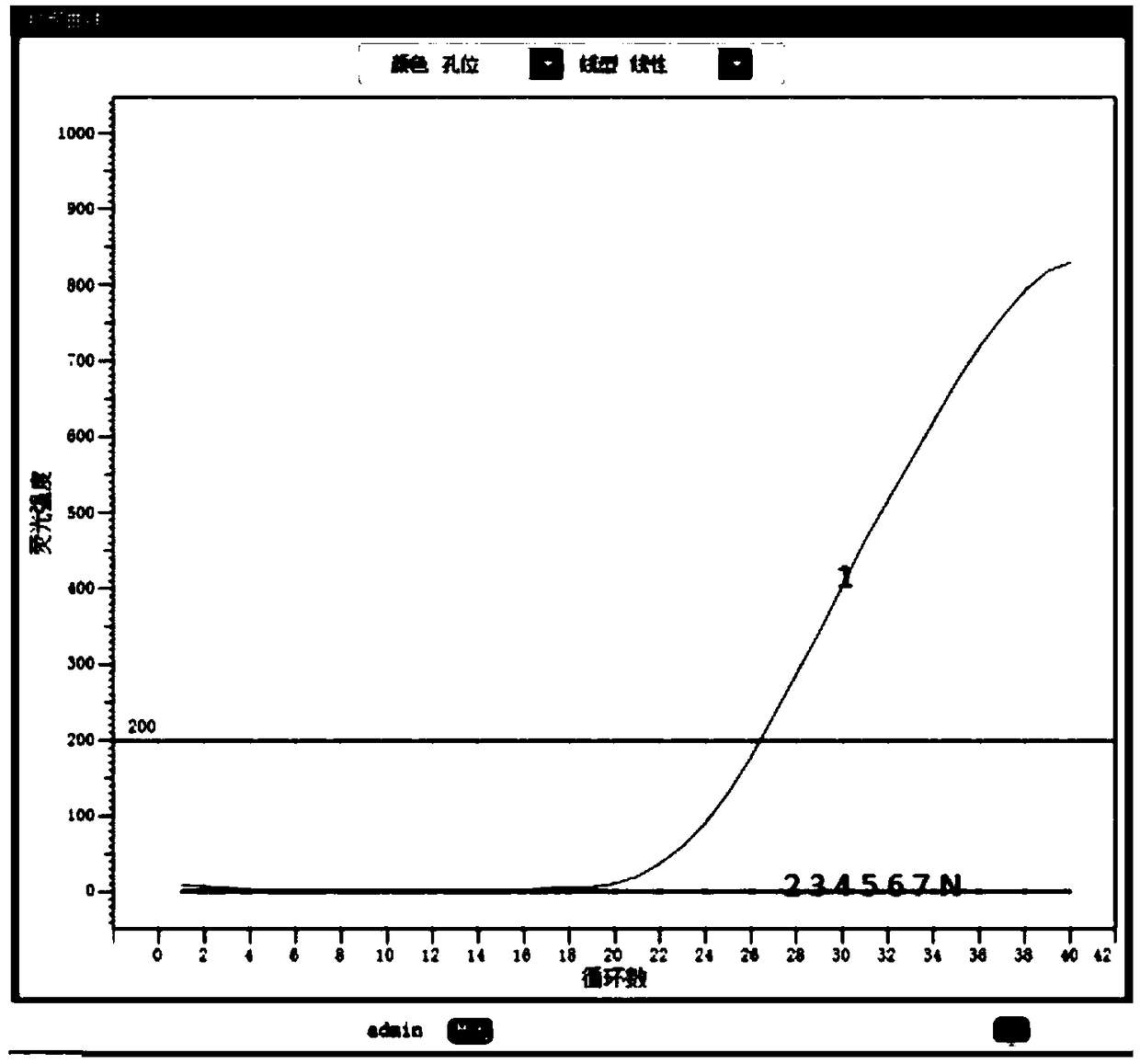Fluorescence quantitative RT-PCR primers and probe and method for detecting APPV (atypical porcine pestivirus) as well as application
A type of atypical pestivirus, fluorescent quantitative technology, applied in biochemical equipment and methods, microbe measurement/inspection, DNA/RNA fragments, etc., can solve the problems of large gene sequence differences, rapid gene sequence variation, and inapplicability, etc. Achieve the effect of less operation steps, saving time and avoiding false positives
- Summary
- Abstract
- Description
- Claims
- Application Information
AI Technical Summary
Problems solved by technology
Method used
Image
Examples
Embodiment 1
[0024] Example 1 Primer Design
[0025] According to the domestic and foreign strain sequences of the APPV gene registered by NCBI (KU041637, KU041638, KU041639, KU194229, KX929062, KX929063, KX929069, LT594521), the specificity of the 5' end gene of APPV was designed using Beacon Designer7.7 software Primers, all primers were synthesized by Shanghai Sangon Bioengineering Co., Ltd.
[0026] Upstream primer APPV F: YGAGTAGTACACCCAAAG (wherein Y represents T or C), SEQ ID NO: 1;
[0027] Downstream primer APPV R: CACCACCGATTTCTCTTTT, SEQ ID NO: 2;
[0028] Probe sequence APPV Probe: CYGAGCCTCAGTAGACCCT (where Y represents T or C) SEQ ID NO:3.
Embodiment 2
[0029] Embodiment 2 detects the establishment of the fluorescent quantitative RT-PCR method of porcine atypical fever virus:
[0030] The method includes the following steps:
[0031] (1) RNA extraction of samples to be tested:
[0032] The blood samples to be tested were centrifuged at 8000g for 5min, and the upper serum was taken for each use; the tissue and organ samples should be mixed with sterilized double distilled water at a mass volume ratio of 1:5, centrifuged at 8000g for 5min after grinding, and the supernatant was taken for later use.
[0033] (2) The extracted RNA was added to a reverse transcription kit purchased from Bao Bio Engineering (Dalian) Co., Ltd. for reverse transcription to obtain a cDNA template:
[0034] The reverse transcription step is as follows: mix 4 μL of RNA template, 4 μL of No. 1 5×PrimeScript Buffer, 1 μL of No. 2 PrimeScriptRT Enzyme Mix, 2 μL of No. 4 Random 6mers and 9 μL of No. 5 RNase Free dH2O, and put them into a PCR machine for re...
Embodiment 3
[0037] The determination of optimization, sensitivity, stability and specificity of embodiment 3 annealing temperature, primer concentration and probe concentration
[0038] (1) Optimization of annealing temperature: the annealing temperature in the APPV F / R primer reaction conditions is set at 48°C-54°C, observe the amplification peak pattern of the fluorescent quantitative PCR instrument, and select the one with the smallest CT value as the optimal annealing temperature, like figure 1 As shown, the optimum annealing temperature of the present invention is 54°C.
[0039] (2) Optimization of primer concentration: 20 μL reaction system for PCR, 0.2 μL to 1 μL for upstream and downstream primers, 0.5 μL for probe. Select the primer concentration with the smallest CT value as the optimal primer concentration, such as figure 2 As shown, the optimal primer concentration is 0.5 μL.
[0040] (3) Optimization of probe concentration: 20 μL reaction system for PCR, 0.8 μL of upstrea...
PUM
 Login to View More
Login to View More Abstract
Description
Claims
Application Information
 Login to View More
Login to View More - R&D
- Intellectual Property
- Life Sciences
- Materials
- Tech Scout
- Unparalleled Data Quality
- Higher Quality Content
- 60% Fewer Hallucinations
Browse by: Latest US Patents, China's latest patents, Technical Efficacy Thesaurus, Application Domain, Technology Topic, Popular Technical Reports.
© 2025 PatSnap. All rights reserved.Legal|Privacy policy|Modern Slavery Act Transparency Statement|Sitemap|About US| Contact US: help@patsnap.com



